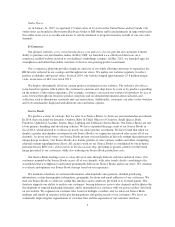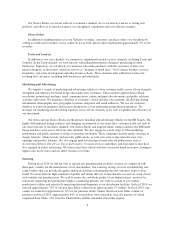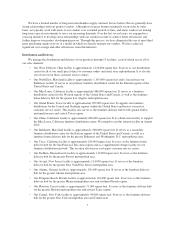Restoration Hardware 2014 Annual Report Download - page 19
Download and view the complete annual report
Please find page 19 of the 2014 Restoration Hardware annual report below. You can navigate through the pages in the report by either clicking on the pages listed below, or by using the keyword search tool below to find specific information within the annual report.open or remodel. If any of these challenges delays the opening of a store, our results of operations will be
negatively affected as we will incur leasing and other costs during the delay without associated store revenue at
such location. New or remodeled stores may not be profitable or achieve our target return on investment.
Unfavorable economic and business conditions and other events could also interfere with our plans to expand or
modify store footprints. Our failure to effectively address challenges such as those listed above could adversely
affect our ability to successfully open new stores or change our store footprint in a timely and cost-effective
manner and could have a material adverse effect on our business, results of operations and financial condition.
If we lose key personnel or are unable to hire additional qualified personnel, our business may be harmed.
The success of our business depends upon the continued service of our key personnel, including our
Chairman and Chief Executive Officer, Gary Friedman. The loss of the services of our key personnel could make
it more difficult to successfully operate our business and achieve our business goals. In addition, we do not
maintain key man life insurance policies on any of our key personnel. As a result, we may not be able to cover
the financial loss we may incur in losing the services of any of our key personnel.
Mr. Friedman’s equity ownership in our Company has given him a substantial amount of personal wealth.
As a result, it may be difficult for us to continue to retain and motivate him, and this wealth could affect his
decisions about whether or not he will continue to perform services for us. If we do not succeed in retaining and
motivating Mr. Friedman, we may be unable to achieve our historical growth rates.
Competition for qualified employees and personnel in the retail industry is intense. We may be unable to
retain other existing personnel that are important to our business or hire additional qualified personnel. The
process of locating personnel with the combination of skills and attributes required to carry out our goals is often
lengthy. Our success depends to a significant degree upon our ability to attract, retain and motivate qualified
management, marketing and sales personnel, and store managers, and upon the continued contributions of these
people. We cannot assure you that we will be successful in attracting and retaining qualified executives and
personnel.
In addition, our success depends in part upon our ability to attract, motivate and retain a sufficient number
of store employees who understand and appreciate our corporate culture and customers. Turnover in the retail
industry is generally high. Excessive store employee turnover will result in higher employee costs associated
with finding, hiring and training new store employees. If we are unable to hire and retain store personnel capable
of consistently providing a high level of customer service, our ability to open new stores may be impaired, the
performance of our existing and new stores could be materially adversely affected and our brand image may be
negatively impacted.
Our operations have significant liquidity and capital requirements and depend on the availability of adequate
financing on reasonable terms, and if we are unable to borrow sufficient capital, it could have a significant
negative effect on our business.
Our operations have significant liquidity and capital requirements. Among other things, we have invested
significant capital expenditures in remodeling and opening new Galleries and these capital expenditures have
increased and will continue to increase in fiscal 2015 and succeeding fiscal periods as we open additional next
generation Galleries, which may require us to undertake upgrades to historical buildings or construction of new
buildings. During fiscal 2014, we spent $110.4 million for capital expenditures. Additionally, we made payments
of $9.3 million in fiscal 2014 to escrow accounts for future construction of certain next generation Galleries. We
anticipate our gross capital expenditures to be approximately $140 million to $160 million for fiscal 2015, which
we anticipate to be offset by approximately $10 million to $20 million due to landlord contributions and other
capital inflows related to our real estate transformation and portfolio. We plan to continue our growth and
expansion, including opening next generation Galleries in select major metropolitan markets, pursuing category
extensions of our brand, and exploring new business areas. We own the building and land for our Gallery in San
15
























